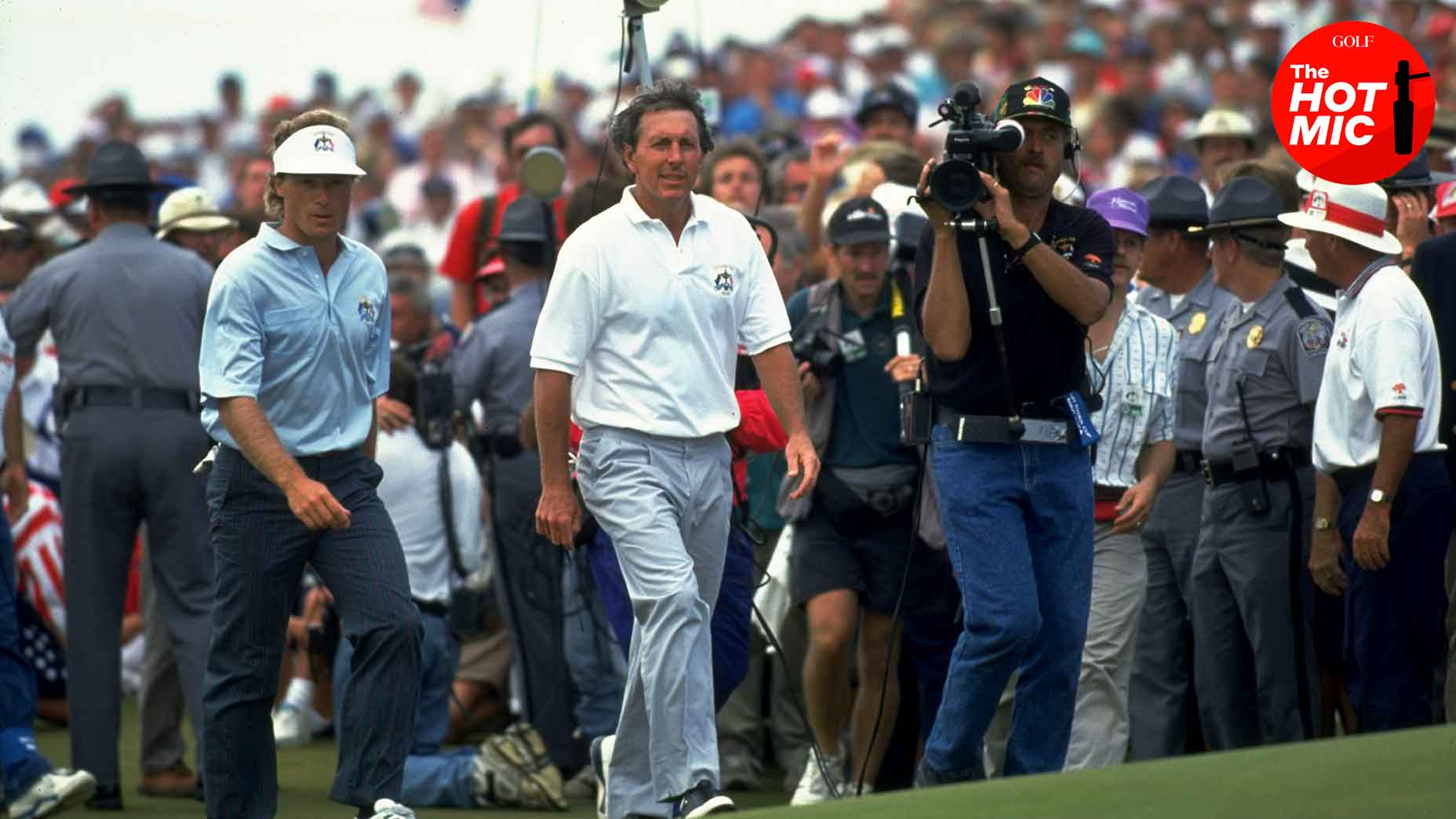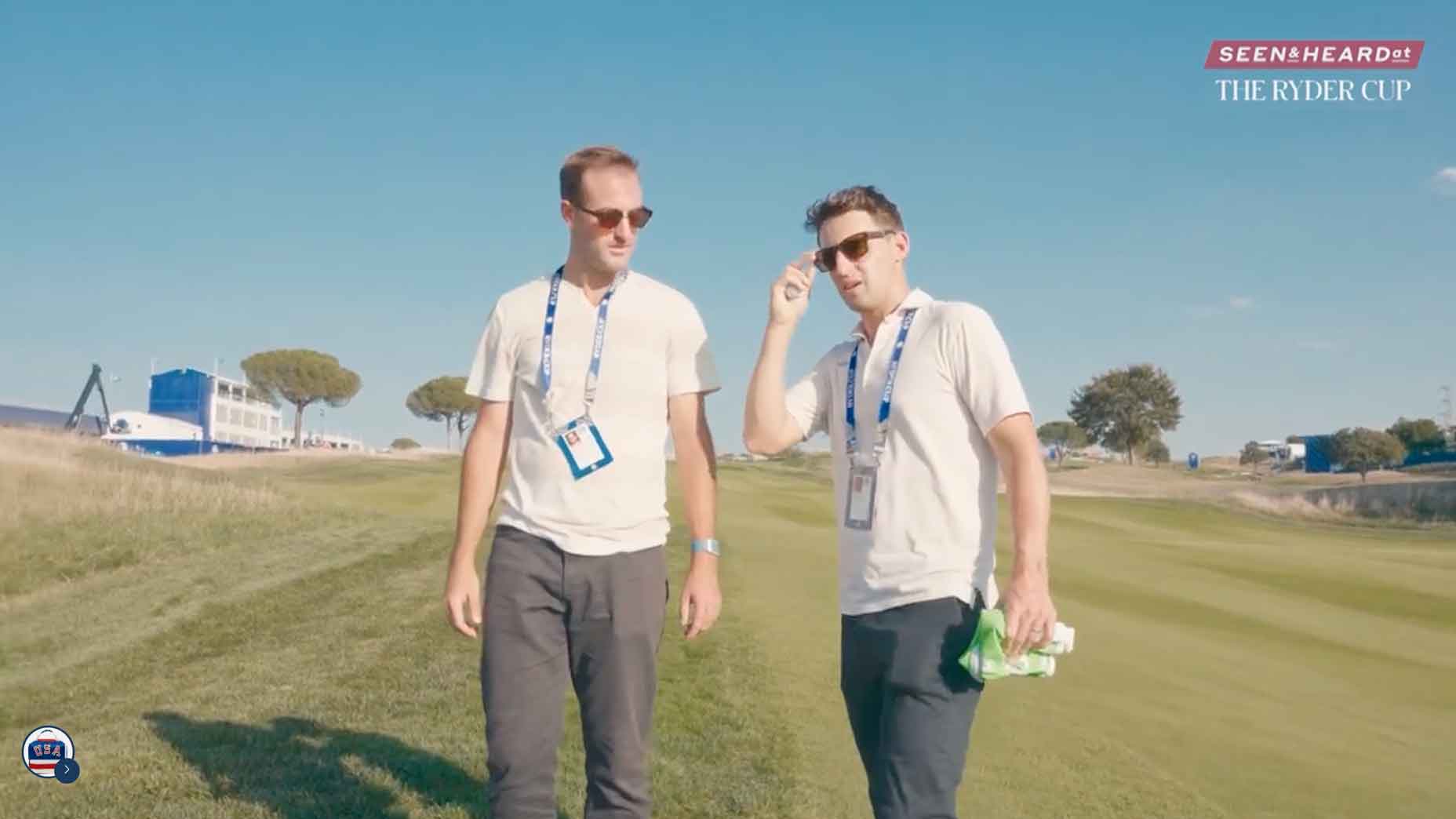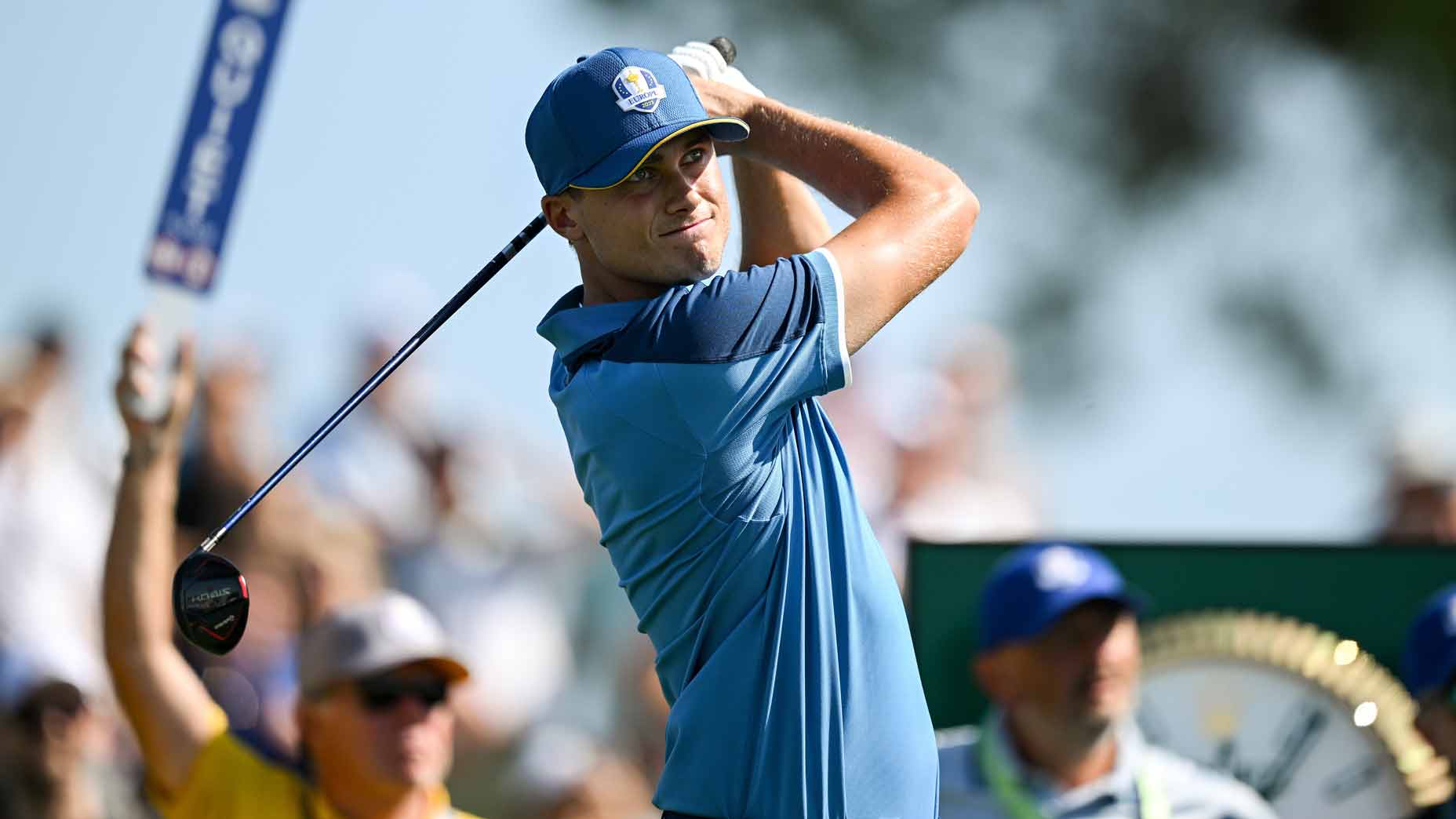
The “War on the Shore” couldn’t have come at a better time.
Getty Images
ROME — The TV people are hard to miss at this year’s Ryder Cup — literally.
Big, neon-green “MEDIA” bibs hang from over their shoulders and are visible from roughly halfway across the property at Marco Simone, while televisions showcasing their work blare from around every corner in the tournament’s hulking buildout, one of the largest in the sport of golf in 2023. When the crews arrive in full on Friday morning, they will with millions of dollars worth of production support and one of the biggest broadcast footprints in golf. They will also be unavoidable from inside the ropes, their lenses seeing, and capturing, everything.
TV is responsible for breathing life into the Ryder Cup, turning it from a biennial event for diehards into the lifeblood of match play golf and the centerpoint of a whole year’s worth of the golf news cycle.
But the truth is that TV only found its way to the Ryder Cup by accident, thanks to a failed TV rights negotiation, an international conflict and a hotshot young NBC exec with a vision. This is the story of how the Ryder Cup became the Ryder Cup, and Jon Miller is its protagonist.
It was on Dec. 14, 1988 — just days before Christmas — when the news landed like a faceplant on NBC Sports Executive Producer Dick Ebersol’s desk.
Ebersol, a legend in the industry, had just received the official word from Major League Baseball: NBC had lost the rights to the most profitable show in its repertoire, baseball’s Saturday Afternoon Game of the Week. CBS and the president of its sports division, Neal Pilson, had signed up to pay a king’s ransom for the same TV rights beginning in 1990, betting that baseball was the way of the sporting future. The agreed cost? A princely $1.6 billion over four years. (In an ironic twist, CBS would lose an unheralded $170 million on the MLB agreement, one of the few true flops of the modern sports TV era.)
The NBC brand had carried baseball under the Saturday Afternoon Game of the Week umbrella for some 41 consecutive years, making it one of the cornerstones of the peacock portfolio. Ebersol, a legendary producer perhaps best known for being the creator of Saturday Night Live, suddenly had a problem on his hands: NBC Sports now had 32 weeks of sports airtime available for rent when the 1990 season began — and no sports properties to fill it.
Jon Miller was one of Ebersol’s deputies at the time the MLB rights were lost, and he remembers clearly the mandate given by Ebersol:
“Go find me some new programs.”
Miller, a rabid sports fan, started combing through his rolodex.
“One of the things that was really interesting to me was that we had golf, but we didn’t have any majors,” Miller says. “The biggest event we had back then was the Players, and that was really the extent of it. So we wanted to find some new options.”
Miller quickly circled in on the Ryder Cup, a golf property without a television partner that happened to have all the elements of blockbuster TV. There was just one problem: it wasn’t very competitive. Three straight Cups had gone by since the last American victory, with the stars and stripes getting waxed in ’85 at The Belfry, losing narrowly in ’87 at Muirfield Village, and tying in ’89, again at The Belfry.
Still, the options were limited, and some members of the European team, Seve Ballesteros chief among them, seemed like ideal characters for TV. So Miller pitched Ebersol, and was delighted to find the EP on board.
“Nobody had ever aired the Ryder Cup live and given it the attention it deserved,” Miller remembers. “That was appealing.”
NBC approached the Ryder Cup with an unorthodox offer: rather than pay the PGA of America a rights fee, as is typical for sports rights, the two sides would model their partnership after another prominent sports media rights structure.
“We would take on a model much like Augusta,” Miller said. “We would have two corporate partners — in this case it was going to be Cadillac and IBM — and we were going to charge them $2 million each for their sponsorship. Out of that $4 million, we were going to pay the PGA of America $2 million, it was going to cost us about a million dollars to produce the event, and NBC would make whatever was left — about a million bucks.”
The ask was too good to refuse. The PGA of America signed on the dotted line late in 1989, and the two sides agreed to a new kind of sports TV rights deal. Everything was coming together perfectly, Miller says…
“And then 1990 happened.”

Getty Images
NBC was about the last place anybody had their attention placed in the fall of 1990, when Pres. George H. W. Bush authorized the invasion of Kuwait and started the conflict now known as the Gulf War. But make no mistake, inside network headquarters, the war was being felt.
It wasn’t long after the first invasion that NBC received devastating word from its two premier corporate sponsors, Cadillac and IBM: they were backing out of their Ryder Cup agreement. With the war deeply unpopular and the economy still in a recession, the two sponsors felt uneasy about putting any more spending behind such a nationally charged event. Suddenly, NBC was caught with its pants down.
“We were left holding the bag,” Miller says with a dark chuckle now. “The Ryder Cup was literally four months away and we did not have anything at all sold in the package.”
Miller and Ebersol hit the street, talking to any sponsor who would listen. They started with golf brands, but were surprised to find interest tepid in the Cup. One particular meeting stood out.
“I’ll never forget the people there laughing at us and offering us 15 cents on the dollar,” Miller says. “They said, ‘Nobody cares about the Ryder Cup; nobody’s gonna watch fourth-quarter golf.’”
Miller remembers receiving an earful from Ebersol after that meeting.
“His business side was second-guessing our involvement and wondering why we made the commitment,” Miller says. “But in the sports department, we believed.”
Eventually, NBC convinced one premiere sponsor, Subaru, to come in for significantly less than they had originally budgeted. The tournament wouldn’t be a total loss for the network.
September arrived quickly, and the Ryder Cup with it. Miller says he feels stress just talking about the days leading into the tournament, even now, because he knew his job was on the line.
The event started about as awfully as Miller could have imagined. The U.S. fell down considerably on the first day, trailing heavily heading into the weekend. Miller knew what that meant: interest from the U.S. TV audience would be nonexistent in a European blowout.
As the weekend progressed, the U.S. cut into the lead considerably, eventually claiming a dramatic, come-from-behind win on the 72nd hole, when Bernhard Langer’s putt to retain the cut missed.
The story couldn’t have played out any better for TV, Ebersol himself admitted, as the ’91 Ryder Cup quickly entered tournament lore as the “War by the Shore.”
“That match really got us off to a spectacular start, and the rest is history,” Miller said. “We go to The Belfry again in 1993. And it was a pretty amazing event from there.”
The Ryder Cup was a ratings success, and before long it was a key piece of the NBC Sports portfolio, where it has remained ever since. In the years that followed, NBC was able to win over the rights to the U.S. Open and Open Championship, expanding from a player in the sport to one of golf’s two biggest broadcasters. All the while, the Ryder Cup has become one of the sport’s biggest moments — and properties.
Miller says it’s hard to overstate what the development of the Ryder Cup has meant to NBC, but you don’t need to spend much time walking around the Ryder Cup to see it.
Just look for the neon green.








